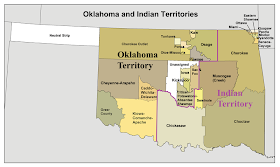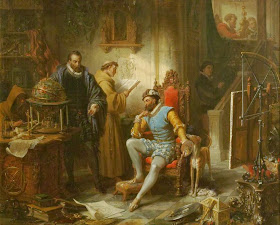I suggest
that if you a member of that half of Americans who believe there is
some validity in astrology, you contemplate the chart for December
30, 1867. It falls under the sign of Capricorn and the double
influence of Saturn. Astrology predicts a person born on this date
should be practical and realistic, with “entrepreneurial talents”.
Our particular birthday boy, Henry Simpson Johnston, was a respected
Biblical scholar, a “frail, bookish” lawyer who sought the
numerological balance of the “5” in all things, believed he had
lived three lives before he'd been born outside Evansville, Indiana,
and adhered to esoteric Christian mysticism known as a Rosicrucian. He
believed in astral-projection. He practiced hypnotism. He was active
in the Klu Klux Klan, a Grand Mason, a founding father and the
seventh Governor of Oklahoma, and the second Governor in seven years
to be impeached.
“Capricorn:
The stars say that you're an exciting and wonderful person, but you
know they're lying”
Al Yankovic
Poet and Social Commentator
Until
1907 it looked as if there would be two states between the Arkansas
Plateau and the Great Plains along the 35th
latitude: Sequoya in the east for the 60,00 “Native Americans”,
and a separate state for the 1.5 million “European Americans”,
mostly in the center and west. That year the Federal government
forced a compromise, and on November 16, admitted the single whole
as Oklahoma. That date made the oil rich Sooners, Scorpios:
resolute, secretive, passionate, insensitive and stubborn to a
fault. Which may explain why, in 1924 another ex-Hoosier became
Oklahoma Governor. Jack Walton had the support of prohibitionist
farmers, Masons, Catholics and progressives in central and western
Oklahoma. But his active opposition to the Klu Klux Klan led to his
impeachment after less than a year into his four year term.
“I don't
believe in astrology; I'm a Sagittarius and we're skeptical.”
Arthur
C. Clarke Scientist and Author
In November
of 1926, Henry Johnston (above) won the Governorship with 56% of the votes.
He was a “slim, long-nosed lawyer, with dark-rimmed spectacles”,
a bookish moralist, given to long rambling speeches on Biblical
proverbs and reincarnation. He was “intolerant of opponents,
(and) seemed blind to weak friends” .Henry and his wife Ethel
attended seances with his close friend, appeals court Judge James
Armstrong, who Governor Johnston put on the public payroll in January of 1927 to
provide the new Governor with astrological advice on all things
political, such as the most prescient hour to sign bills into law.
And then Henry hired Judge Armstrong's niece as Oklahoma's first
gubernatorial confidential executive secretary.
John Kenneth
Galbraith Economist
Her
name was Mrs. Oliver O. “Mamie” Hammonds. The “small,
attractive, dark-haired” and “formidable” Mamie had been a
Democratic worker for years, and a successful oil well wildcat-er in her own right.. As
the Governor's secretary, she took dictation, typed, screened the
Governor's visitors and, to save money, astral-projected across the
state's 68,595 square miles to do background checks on job
applicants. She was also in the Klan's woman's auxiliary,. But
it was not Mamie's affection for the supernatural which initially
drove the legislature batty, but according to a reporter for the
Daily Oklahoman, it was because “She
controlled the door to the governor. Legislators, friends, and
supporters...found themselves unable to see the governor unless she
acquiesced.” This irritation simmered during the first legislative
session, and then rose to a boil during the summer break because of
the deep systemic corruption of Oklahoma's government.
“Millionaires don't have astrologers,
billionaires do.”
J.P. Morgan.
Banker, ego maniac
Under the
state's compromise constitution, each of Oklahoma's 77 counties was
ruled by an elected three member council, with absolute power,
setting salaries and awarding contracts for construction and
maintenance for all county property. The graft was so ingrained that
a county commissioner who required only a 10% kickback on contracts
was hailed as “a model public servant”. To protect this system,
Oklahoma violated their own constitution by refusing to redraw
Congressional districts for sixty years. Graft and lethargy was part
of the reason the state Capitol building (above) in Oklahoma City, still
lacked a dome a decade after all other construction was completed. It would not get one until 2002. Of
course none of this prevented Oklahoma hypocrites from asserting
their moral superiority over the rest of America.
“Horoscopes are nothing more than a
mass cultural delusion that the sun's apparent position relative to
arbitrarily defined constellations at the time of your birth somehow
affects your personality.”
Dr. Sheldon
Cooper Sitcom physicist
Above this
swamp of graft the state created a five member commission to build
highways. Both of the new commissioners Governor Johnston appointed
were members of the KKK, and they hired further Klan members. That
weakened Johnston's support from Catholics, making him vulnerable.
He was not helped by his procrastinating. He almost seemed bent on
self destruction, “by turns spectacular and pathetic.” But it was
Johnston's insistence that concrete be used in highway construction -
as opposed to asphalt, which Oklahoma was swimming in - Oklahoma
oil hit its peak production level in 1927 (above), at 278 million barrels –
that really set the boil to roiling.
"Everybody
has a birthday and almost everybody has a palm."
Kurt Vonnegut
Author
Sensing the
Governor's weakness in the fall of 1927, the few Republicans in the
legislature and rebellious Democrats signed a petition asking the
Governor to call them into special session so they could impeach him.
When he refused, they decided to meet anyway. Led by their leaders
“The Four Horsemen”. legislators labeled Mamie Hammonds as the
Shadow Governor, and the “She-svengali” of Oklahoma. She was put
under oath and freely admitted her astral-travels, but denied she had
done anything without Johnston's specific orders. Still, the
legislature demanded Mrs. Hammond's resignation.
Paul Carvel
Belgian Author
When
questioned if he was willing to fire his executive secretary,
Governor Johnston (above) typically responded with a parable. “If you came
to me with a thousand sheep, and I had only one ewe lamb and you
wanted me to destroy that, do you think I would be so base as to
destroy it? I repeat, gentlemen, it would be yellow, it would be
unjust to Mrs. Hammonds to sacrifice her and her character on false
charges.” Henceforth the impeachment became known as the Ewe Lamb
Rebellion. Then Governor Johnston decided to strike back. When the
“Horsemen” legislators showed up on Monday morning, Christmas day
of 1927, they found seventy National Guardsmen blocking the door to
the capital building. So they took testimony in the nearby
Lee-Huckins Hotel, until the state Supreme Court ruled the
legislature could not call themselves into special session. Wrote the
Oklahoman, “Unhorsed, unhonored, unpaid and hamstrung, the rebel
leaders and insurrectionists returned to their home".
Pisces: Try
to avoid any Virgos or Leos with the Ebola virus
Al Yankovic
Poet and Social Commentator
But
the battle was merely postponed, until early 1929, when the House of
Representatives filed 11 charges against Governor Johnston. The only
new issues concerned Dr. Oliver O. Hammonds, who had been appointed
Governor Johnston's Secretary of Public Health. He was the
“disarming and dimpled” Mamies' husband. Her brother Scott sold
machinery to the state highway department. And Governor Johnston's
closest political adviser, Judge Armstrong, was Mamies' uncle, who was also an attorney for an insurance company that bonded the state
highway department. The thinking seemed to have been there must be
fraud somewhere in all those relative connections. But nothing was ever produced.
“In many ways, astrology, numerology
and palmistry...have attempted to make a practice out of something
that is essentially imaginative.”
Isaac Bashevis Singer Author
After a two
month trial the state Senate acquitted Governor Johnston of ten of
the charges, agreeing with Oklahoma founding father, William
“Alfalfa” Murry (above), that conversing with “nymphs, gnomes and
newts", was not an impeachable offense. “You must remember”,
he told the Senators, “the people have a right to elect a fool.”
However, that March, even after Mrs. Hammonds resigned, the
Senators convicted Governor Johnston of the eleventh charge; general
incompetence.
Al Yankovic
Henry
Johnston and Ethel packed their four adopted daughters into the
family car, and drove the 40 miles north to his hometown of Perry. To
his surprise he was met on the outskirts by hundreds of well wishers (above),
who escorted the family to the county courthouse. There he gave one
more speech. “I have lost the office of governor. I have retained
my honor and integrity. I retire with a clear conscience. I retain
the public confidence” And he did, as he was quickly elected to a four year term in
the state Senate . Then he returned to Perry again, to practice law
until his death, in January of 1970. Then we can only assume, he
started it all over again.
Douglas Adams Author



















































